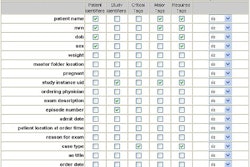BOSTON - Consumer-grade color flat-panel monitors may perform just as well as medical-grade, high-luminance monochrome cathode-ray tube (CRT) monitors in the primary diagnosis of abdominopelvic CT exams, according to preliminary research from Massachusetts General Hospital in Boston.
CRT monitors are rapidly being replaced in radiology departments by flat-panel displays. And with brightness levels up to 80 foot-lamberts, consumer-grade monitors are now bright enough to be considered for some applications, said Dr. David Hirschorn, a radiologist and clinical fellow in informatics and MRI at MGH and Harvard Medical School. He presented preliminary findings Sunday during a scientific session at the Symposium for Computer Applications in Radiology.
"Huge amounts of money can be saved by radiology departments, if you understand where and when to use the right kinds of monitors," he said.
A five-megapixel, medical-grade, monochrome liquid-crystal display (LCD) with up to 200 foot-lamberts of brightness can range in price from $15,000 to $20,000, while a consumer-grade, two-megapixel color display with up to 80 foot-lamberts can cost approximately $750 to $1,000. Although not suitable for the high-brightness and resolution demands required for radiographic studies, the lower-end display can more than handle the 0.25-megapixel resolution of CT studies, Hirschorn said.
"Often the findings of non-radiographic studies are typically of higher contrast than radiography, and we routinely window and level them anyway," he said.
In addition, the consumer-grade display meets the American College of Radiology's minimum display standard of at least 50 foot-lamberts.
As part of research to test their hypothesis that there's no significant difference between consumer-grade flat-panel displays and the monochrome medical-grade CRT displays, the MGH research group queried seven of its radiologists for subjective comparisons of the two systems.
The radiologists were asked:
- Are you as confident, less confident, or more confident of your diagnosis in general on the flat-panel systems?
- Do you find calcifications less, the same, or more conspicuous?
- Do you find hemorrhages less, the same, or more conspicuous?
- Do you find tumors less, the same, or more conspicuous?
- Do you find edema in the fat less, the same, or more conspicuous?
- Were it not for the limitations of being unable to manipulate the PACS while dictating, do you prefer having both the PACS and speech recognition on the same computer with one mouse and keyboard?
- Do you prefer the flat-panel system or the CRT system?
Four out of the seven radiologists were as confident with their diagnosis in general with the flat-panel display, with one slightly less confident and two who didn't know.
Five of the radiologists had the same level of confidence in looking at calcifications, one had slightly less, and one didn't know. For conspicuity of hemorrhage, four said they were as confident, one slightly less, and two said they didn't know.
One radiologist was more confident with tumor conspicuity with the flat-panel display, four had the same level of confidence, one had less confidence, and one didn't know. For edema in the fat, three were as confident, one was less confident, two were slightly less confident, and one didn't know.
All seven said they preferred having PACS and speech recognition on a single computer with one mouse and keyboard. As for general preference between the flat-panel and CRT systems, it was a wash, Hirschorn said.
"Our preliminary conclusion for now is that yes, consumer-grade flat-panels are comparable for diagnosing abdominopelvic CT exams," he said.
In a response to an audience question, Hirschorn said that consumer-grade monitors can be calibrated using commercially available calibration packages. One such product, VeriLUM (Image Smiths, Germantown, MD), can calibrate at a level coming very close to 10-bit grayscale, Hirschorn said.
"As far as I'm concerned, this (calibration of consumer-grade monitors) issue has been solved," he said.
By Erik L. Ridley
AuntMinnie.com staff writer
June 8, 2003
Related Reading
PACS displays raise myriad issues, March 14, 2003
Medical imaging workstations: What you need to know, May 22, 2002
Digital departments need rigorous QA program, May 5, 2002
Monitor choice impacts diagnostic accuracy and throughput, May 4, 2002
Monitor firms pursue automatic display calibration, May 4, 2002
Copyright © 2003 AuntMinnie.com



















